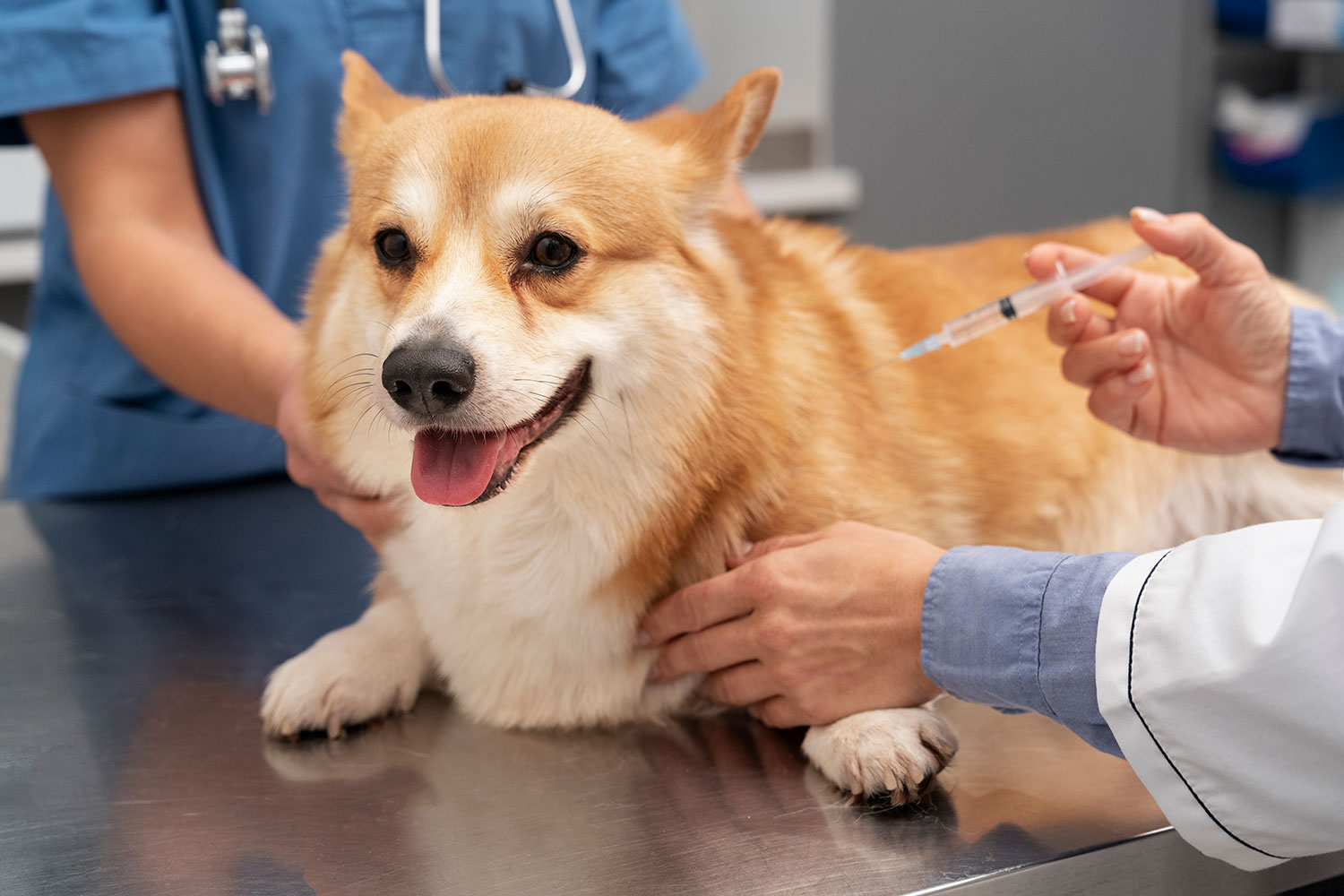Home » Pet Health » Pet Worms » Dog Treatment and Prevention
Dog Treatment and Prevention

Treatment at the Vet
Most parasitic worms are species-specific. However, humans can also get parasitic worms from cats. Accidental infestation can come from contact with infected feces or contaminated soil, leading to lung, eye, heart, and neurological problems.
It is essential to know about the different kinds of parasitic worms in cats to protect yourself and your family once your cat becomes infected with worms.
Testing Methods
Fecal Centrifugation
If your pet starts to show symptoms, it is better to ask your veterinarian to perform fecal centrifugation. Fecal centrifugation or fecal flotation is a process where it separates the parasites and other objects in feces depending on their densities. It detects if your dog has parasitic worms or not.
However, since some dogs may not show possible symptoms of worm infection, it is best to perform fecal centrifugation periodically. You must ask your vet to do the test four times during the first year of your dog and at least twice a year every year after. (Companion Animal Parasite Council, 2018).
Fecal Smear
Physical Examination
Intestinal Worms
- Tapeworms
Veterinarians usually treat tapeworms through medications taken orally or injection. Treatment can also include getting rid of any fleas in your dog or house. The process can break off the parasitic worms in the intestinal tract, making them too small to see in the feces of your dog.
- Roundworms
Your vet can diagnose roundworms by using fecal samples. Roundworms usually require medications for removing worms, which detach the worms from the intestinal tract. It then excretes them into the stool of the dog.
- Hookworms
Usually, vets diagnose hookworms through microscopic examinations of the stool or the process of fecal centrifugation. Treating hookworms also require medications for removing worms. However, your vet should administer the medicine twice. The first one is to catch adult worms, and the other one should be after 2-4 weeks to kill new adult worms.
- Ringworms
Your veterinarian may recommend various methods in treating ringworms. These methods may include using lime-sulfur dips, antifungal medications, shampoos, or shaving severely affected areas.
- Whipworms
Your vet also diagnoses whipworms through fecal samples. After the diagnosis, your vet will recommend a treatment plan for curing the worm infestation. Usually, treatments may take three months. Moreover, whipworm eggs are also uneasy to find, so there may be false negatives. With that, it is best to take fecal exams repeatedly.
- Heartworms
The treatment for heartworms is expensive and lengthy. It can also cause serious side effects to your pet. That is why the American Heartworm Society recommends a 9-month treatment protocol.
Heartworm
Heartworms usually require a more different treatment than any other parasitic worms in dogs. First, your dog will need to undergo blood tests and take several x-rays to determine if the infestation has become worse or not. However, these tests can be pretty expensive. They typically cost around $500- $1,000, depending on your location and the severity of the disease.
After that, your dog will start undergoing heartworm prevention medication, inflammatory medication, and antibiotics. After about a month, your vet will administer heartworm medication, consisting of three shots over two months.
After getting the shots, it’s best to keep your dog relaxed and calm in the following months. When the medicine starts to kill the heartworms, they will break into small chunks, blocking the blood circulation to the lungs or heart. There is a higher possibility of this happening when your dog exercises and the blood pumps faster or harder than usual.
Six months after the heartworm medication, your veterinarian will perform another blood test to ensure if the worms have become eradicated. If the parasitic worms are still present, your dog will need to undergo another round of shots. Otherwise, you will only need to continue giving your pet preventive medication for the rest of their lives. Plus, it is also crucial to have your dog tested every year for heartworms to be safe.
When it’s time for the annual vet check-up of your dog, contact the office of your vet beforehand. You must ask your vet if you need to provide a stool sample for the vet to check under a microscope during the visit. If yes, scoop up a stool sample immediately after your dog defecates and seal it in a plastic bag.
Your vet can also take a sample from your dog during the examination if you don’t feel comfortable collecting a stool sample yourself. The veterinarian may also take a blood sample during the exam to test for heartworms, which is the most effective way to diagnose that particular worm.
Treatment At Home
Eradicating Worms
Puppies
Parasitic worms can pass from a mother dog to a puppy in utero or after birth through her milk while nursing. Since parasitic worms are common in puppies, veterinarians often suggest curing worm infestations in puppies as soon as possible, significantly when they are between two to three weeks old.
Veterinarians also recommend administering anthelmintic medicines (medicine used to destroy parasitic worms) every two weeks after the initial dosage. This is until the puppies start a regular broad-spectrum parasitic control treatment.
If you choose to treat your dog using home remedies, you can find several anthelmintic medicines online. If not, your vet can prescribe them for you. The first take of medicines will kill the adult worms in the guts of puppies, and the second dosage will kill the worms that hatched from the eggs a few weeks after (Pet WebMD).
Dogs
Treating a parasitic worm infestation in adult dogs is very similar to treatment for puppies. Your veterinarian will most likely prescribe an anthelmintic (medication for curing worms), which is different and tailored to the specific type of worm.
Some medications will break the worm up inside the intestines. On the other hand, some treatments detach the worms from the intestinal tract and excrete them in the feces. There are anti-fungal shampoos and topical medications that your veterinarian can also prescribe to use on a dog’s backside externally.
Is It Dangerous to Humans?
If you want to try a home remedy approach and take a more natural and holistic route, there are many different herbs and vegetables to try. According to Rita Hogan, a canine herbalist and co-founder of Farm Dog Naturals (herbal remedy company for the All-Natural Dog), many foods can aid in making your dog’s intestinal tract less appealing to worms. Some of these foods include:
- Papaya
- Watercress
- Fennel
- Greens
- Squash
- Pumpkin; and
- Carrots
Prepare at least 1/2 tsp per 10 lbs. of your dog’s body weight of the fruit or vegetable you choose from above and give it to your dog twice a day.
Hogan's Tips for Eliminating Worms
Tapeworms
Sprinkle dried coconut onto food. Prepare about 1 tsp for small dogs, 2 tsp for medium-sized dogs, and 1 tbsp for large dogs.
Roundworms
Orange vegetables such as carrots, squash, papaya, and pumpkin can provide vitamin A which can help get rid of roundworms.
Worms in General
- Raw and organic pumpkin seeds – Grind the pumpkin seeds and mix them with ground meat.
- Black seed or black cumin seeds – Indigenous populations have known these seeds as “the cure for everything except death.” Mix ½ to 1 tsp of the seed (depending on the size of your dog) to its food every day. You can also heat the seeds first to get rid of the bitter taste.
- Olive leaf extract – People usually sell this extract in different strengths of oleuropein, a compound found in the fruit and leaves of olive trees. It is better to find an olive leaf extract that is at least 12% oleuropein or higher.
Dosage Tips
Hogan also suggests dosing ten days on, five days off, and then ten days on again to get the most effective results. She states that it takes ten days to kill the worms. However, these worms may have laid eggs, creating another generation of them in the intestines.
Usually, these eggs will take five days to hatch. With that, you will need to repeat the treatment to kill the new generation. Moreover, they also recommend bringing in another stool sample to your veterinarian after you have completed several rounds of treatment to confirm if the parasites have been completely removed (Dogs Naturally Magazine, 2018).
*Disclaimer: We do not guarantee remedies will work or that we have tried them. Always consult a vet before trying anything. This article is purely informative.
Prevention
Worm infestation prevention aims to reduce the risk of chronic disease, and a preventative health plan is essential to be proactive about keeping your pet healthy. Thankfully, there are various steps that you can choose from when reducing the risk of parasitic worm contraction.
If you take the proper precautions, you can protect yourself, your family, and your dog from potential exposure. Below are some of the best prevention methods to try for parasitic worms in dogs. Remember, prevention is the best practice, and it will keep you and your family — both human and furry — happy and healthy!
Remove Fleas
Controlling flea problems can help prevent parasitic worm infestations. Since fleas can carry worm larvae, there is a tendency where your dog may swallow an infected flea while cleaning itself. The worm will grow inside the intestine of your dog and attach itself to the gut walls.
To prevent and remove fleas, you should frequently vacuum and wash pet bedding, carpets, and furniture. Flea treatment can protect, remove and break the flea life cycle, which in turn can prevent a worm host from entering your furry friend’s body.
Dead Animals & Trash
Dead animals are the primary carriers of parasitic worms. It is crucial to keep your dog away from carcasses, such as birds, that may be lying around. It is best to remember that dogs explore with their mouths, so anything on the ground has the potential to enter the body of your dog.
Additionally, trash can have similar hosts and can be a breeding ground for worms. Keep your pup on a leash to prevent it from rummaging around trash cans and waste.
Symptoms
Lungworms can mainly cause severe respiratory and breathing conflicts. Your pet may encounter shortness of breath, feline asthma, wheezing, or coughing. The larvae in the airway may lead to coughing, resulting in an abundance of mucus and difficulty breathing.
If left untreated, symptoms may worsen, including fluid-build-up in the lungs or pneumonia.
Good Everyday Practices
- Cover sandboxes outside while not in use. Animals often use these sandboxes to relieve themselves, and they can become contaminated with worms and larvae from them. Check out our blog for more information about the potential risks of sandboxes and how to protect your pets and children.
- Pick up and clean feces immediately. Usually, feces can transfer parasitic worms and diseases from one dog to another.
- Please keep dogs on a leash while not at home to prevent them from getting into the trash or picking up a dead animal.
- Wash your hands immediately after handling feces or other animals.
Eye Worms are whitish parasites that move in a snake-like motion across the eye of a cat. There can be up to 100 eyeworms in the tear ducts and on the conjunctiva under the eyelids (Merck Veterinary Manual). The species is usually present in western North America, and there are more cases around late spring and summer when flies are more active.
Disinfect
It is essential to clean your home and yard during and after a parasitic worm infestation to eliminate the risk for reinfection. Without disinfecting, your pets may get diseases again from dirt and contaminated areas in your surroundings. To help you with that, here are some ways you can disinfect your home!
Non-Porous Items
Clean and sanitize food and water bowls regularly. Ensure to use only a safe disinfectant for animals, such as a diluted bleach mixture (RSPCA). Prepare 1-part bleach to 32 parts water (or 4 ounces of bleach to 1 gallon of water) to make an animal-safe yet effective solution. You can also use this solution to clean any other non-porous objects in your home, such as plastic toys.
Outdoor Dog Houses or Kennels
Use a vacuum to clean outdoor houses and scrub them with the diluted bleach solution mentioned above thoroughly. Rinse the entire dog house with water first and ensure to dry it before allowing your dog to use it again.
Dog Beds & Fabrics
To ensure that dog beds and fabrics are clean and worm-free, you must sanitize them properly. Please wash beds and clothes in the washing machine using hot water. Ensure to separate them from any clean clothes and dry them on high heat. Spray all furniture that your dog has touched with a household disinfectant spray.
Flooring
Keep the floor clean by vacuuming and sweeping daily or as frequently as you can, and then mop with soapy water. Rinse and allow the flooring to dry first before walking on it again.
Outdoors
Ensure to remove all pet stools in the yard, and you must never use pet waste as fertilizer. Borax, salt brine, or diluted bleach can kill most larvae on concrete or gravel. However, these chemicals will kill grass and plants (hunker.com). You may use a garden hose in rinsing the lawn after disinfecting.
Regular Vet Visits
Regularly visiting your veterinarian is one of the most important steps you can take to prevent worm infestations. Going to vet clinics and having annual check-ups can help determine and diagnose if parasitic worms live inside your dog.
A veterinarian will get a stool sample from your dog, either one you collect and bring in or one collected right there at the clinic. After that, the vet will look at the stool sample under a microscope to inspect if adult worms or worm eggs are present. The earlier the worms become detected, the better the treatment results will be for your puppy!
Top 5 Frequently Asked Questions
Treatment for heartworms is pretty expensive compared to curing any other parasitic worm. The costs are usually around $500 to $1000. However, the expenses depend on the veterinary bills, the size of your dog, and the severity of the infestation.
Usual treatments for heartworms may include blood work for measuring the level of infection, x-rays, Immiticide, pain medication, sedatives, and antibiotics for killing the parasites.
According to Rita Hogan, a canine herbalist and co-founder of Farm Dog Naturals, you can eliminate Tapeworms with dried coconut. Hogan suggests sprinkling the coconut onto food, about 1 tsp for small dogs, 2 tsp for medium-sized dogs, and 1 Tbsp for large dogs.
Aside from that, you can also use papaya, pumpkins, and cloves to get rid of tapeworms. You only need to add some of these to the food of your dog.
There has been no history of dogs transferring lung worms to humans. However, you cannot stay too relaxed. You still need to practice good hygiene and wash your hands frequently to protect yourself.
Looking for whipworm eggs can lead to false negatives because they are uneasy to find. That is why it also takes time to cure them. Usually, your veterinarian will recommend a treatment plan for your pet. The treatment plan typically takes three months.
Aside from that, your veterinarian can also prescribe a deworming medication. This process requires 3-4 weeks intervals and then every 3-4 months to prevent a re-infestation.
Yes! Hookworms are treatable. After diagnosis, your veterinarian will prescribe medication for removing the worms. Your vet will administer medicines twice — one for catching adult worms and one for treating hookworms two to four weeks later.
Other Frequently Asked Questions
Experts do not approve over-the-counter medications for eliminating worms to treat strongyloidiasis, so you need to get a prescription from your veterinarian first. The best medicines your dog can take are diethylcarbamazine, ivermectin, thiabendazole, and fenbendazole.
Your vet will typically administer the medication for at least three days and repeat it every week until larvae become cleared up in feces.
No! Lungworms and heartworms are not the same. Lungworms may live in the heart and major blood vessels in the lungs and cause various respiratory illnesses, but they are not similar to heartworms.
Lungworms can only transfer themselves if a dog ingests larvae in a slime trail found in infected slugs, snails, and frogs, or by eating the snail, slug, or frog itself. On the other hand, heartworms can only transfer through an infected mosquito bite and have four symptom stages that may usually vary in severity.
Blogs

How To Identify Normal Cat Poop From Worrisome Ones?
Your cat’s poop can tell you many things about its health. Its color, shape, consistency, size, content, and odor can

Hairballs in Cats: What Are They & What Are The Signs?
Hairballs are common in cats. This condition, known as trichobezoar, occurs when hair becomes stuck in the cat’s throat, digestive

Colitis in Cats: What You Should Know
Colitis is one of the many gastrointestinal disorders that affect cats. It is a condition in which the intestine becomes

